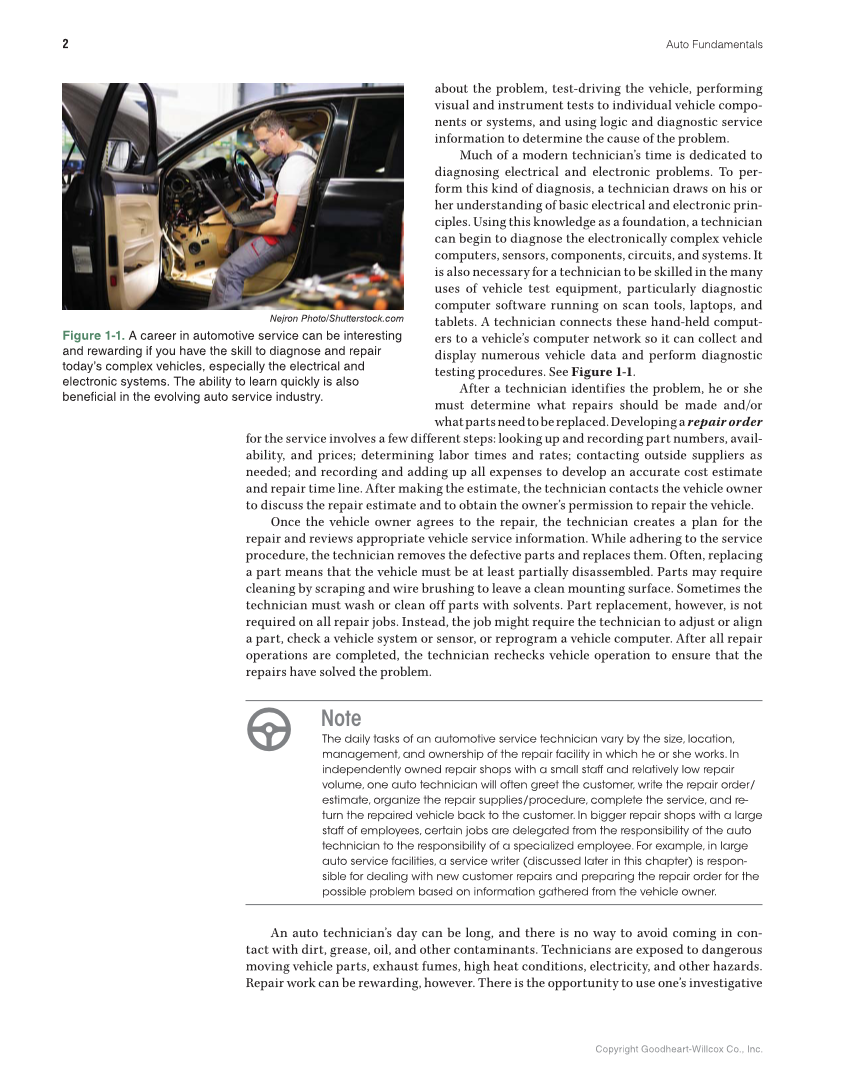Copyright Goodheart-Willcox Co., Inc. Auto Fundamentals 2 about the problem, test-driving the vehicle, performing visual and instrument tests to individual vehicle compo- nents or systems, and using logic and diagnostic service information to determine the cause of the problem. Much of a modern technician’s time is dedicated to diagnosing electrical and electronic problems. To per- form this kind of diagnosis, a technician draws on his or her understanding of basic electrical and electronic prin- ciples. Using this knowledge as a foundation, a technician can begin to diagnose the electronically complex vehicle computers, sensors, components, circuits, and systems. It is also necessary for a technician to be skilled in the many uses of vehicle test equipment, particularly diagnostic computer software running on scan tools, laptops, and tablets. A technician connects these hand-held comput- ers to a vehicle’s computer network so it can collect and display numerous vehicle data and perform diagnostic testing procedures. See Figure 1-1. After a technician identifies the problem, he or she must determine what repairs should be made and/or what parts need to be replaced. Developing a repair order for the service involves a few different steps: looking up and recording part numbers, avail- ability, and prices determining labor times and rates contacting outside suppliers as needed and recording and adding up all expenses to develop an accurate cost estimate and repair time line. After making the estimate, the technician contacts the vehicle owner to discuss the repair estimate and to obtain the owner’s permission to repair the vehicle. Once the vehicle owner agrees to the repair, the technician creates a plan for the repair and reviews appropriate vehicle service information. While adhering to the service procedure, the technician removes the defective parts and replaces them. Often, replacing a part means that the vehicle must be at least partially disassembled. Parts may require cleaning by scraping and wire brushing to leave a clean mounting surface. Sometimes the technician must wash or clean off parts with solvents. Part replacement, however, is not required on all repair jobs. Instead, the job might require the technician to adjust or align a part, check a vehicle system or sensor, or reprogram a vehicle computer. After all repair operations are completed, the technician rechecks vehicle operation to ensure that the repairs have solved the problem. Note The daily tasks of an automotive service technician vary by the size, location, management, and ownership of the repair facility in which he or she works. In independently owned repair shops with a small staff and relatively low repair volume, one auto technician will often greet the customer, write the repair order/ estimate, organize the repair supplies/procedure, complete the service, and re- turn the repaired vehicle back to the customer. In bigger repair shops with a large staff of employees, certain jobs are delegated from the responsibility of the auto technician to the responsibility of a specialized employee. For example, in large auto service facilities, a service writer (discussed later in this chapter) is respon- sible for dealing with new customer repairs and preparing the repair order for the possible problem based on information gathered from the vehicle owner. An auto technician’s day can be long, and there is no way to avoid coming in con- tact with dirt, grease, oil, and other contaminants. Technicians are exposed to dangerous moving vehicle parts, exhaust fumes, high heat conditions, electricity, and other hazards. Repair work can be rewarding, however. There is the opportunity to use one’s investigative Nejron Photo/Shutterstock.com Figure 1-1. A career in automotive service can be interesting and rewarding if you have the skill to diagnose and repair today’s complex vehicles, especially the electrical and electronic systems. The ability to learn quickly is also beneficial in the evolving auto service industry.
